
EGYPT
The modern world owes much of real value to ancient Egypt. It was the Egyptians who first divided the day into 24 hours, and the year into 365 days.
Egyptian hieroglyphs were a model for the alphabet

which was invented in Palestine and came to us through the Greeks and Romans. Names such as "Susan", "ebony", "gum", and "sack" are Egyptian in origin.
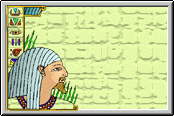

Three scripts were used in ancient Egypt:
hieroglyphic, hieratic and demotic. Hieroglyphic (from
the Greek hieros, "sacred", glypho,
"sculptured") was used from the beginning of Egyptian
history for all purposes. In later times it was restricted to
monumental inscriptions; the last known hieroglyphic inscription,
from Philae, dates to AD 394. Hieroglyphs were probably an
offshoot of pictorial art, 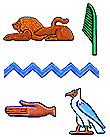 using pictures of things to denote names of other things
which had a similar sound.
using pictures of things to denote names of other things
which had a similar sound.
On stone, hieroglyphs were carved with a chisel. On papyrus, they were written rapidly with a reed pen and soon became abbreviated. This cursive script is called hieratic, (Greek hieratikos, "priestly"), because by the Graeco-Roman Period, this was the ordinary writing of everyday life and was used until the mid-5th century AD.
There were two kinds of signs: phonograms and ideograms. Phonograms represented sounds and were used for spelling. Ideograms, or determinatives, conveyed the general meaning of the word.
A picture of an eye, for example, did not simply mean "an eye" but was added to the words "look", "search" or "watch" to emphasize their meaning. One phonogram could represent one, two, three, four, or even five consonants.
Vowels were not indicated in the script. Most words were made of a group of signs. There are 24 signs each representing one consonant, forming a core "alphabet", but this was not developed and these alphabetic signs were rarely used separately but nearly always in conjunction with other signs.

Personal seals were often carried or worn as rings. They could be inscribed with the owner's name. When impressed on wax or clay they acted as marks of ownership. During the Old Kingdom many such seals were cylindrical in shape. Gradually they were replaced by seals shaped like the
scarab beetle 
Scarab seals were the symbol of the creator sun-god Khepri. Scarab or dung beetles roll balls of dung, which they use as food, along the ground, and lay their eggs in similar dung balls. Egyptians regarded Khepri as a scarab pushing the globe of the sun across the sky because to them, new life sprang from the sun in the same way as new scarab beetles hatched from dung balls. Scarab seals originally served an amuletic purpose, but quickly became used as ordinary seals to authenticate documents, and to guarantee and seal goods.
By the end of the 4th century AD, ancient Egyptian culture had been eclipsed by the influence of Greek thought. The Greeks and Roman writers did not have a proper understanding of Egyptian culture. They could not read hieroglyphs, which were essentially phonetic, but interpreted them as allegorical.
The appeal of things Egyptian was linked to the worship of the gods Isis and Serapis, whose cults spread all over the Mediterranean and were established at Rome by the 1st century BC.
THE PHARAOHS

The king in ancient Egypt was regarded as a god. He was thought to be the incarnation of the god Horus, and was often called "the good god". At death, the king was identified with Osiris, the god of the underworld. Kings are easily identified on Egyptian monuments. They normally wear a crown, a uraeus (a cobra on the forehead) and a false beard.
When Khufu, also known as Cheops, became pharaoh, one of his first acts was to curtail the growing power of the priesthood. He closed all the temples and forbade sacrifices.
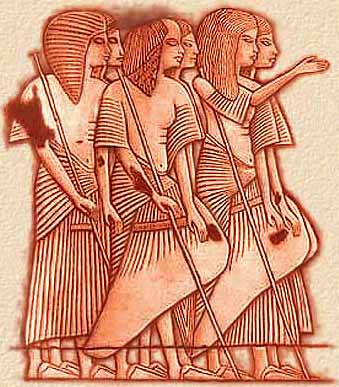
Women in royal families were generally considered the equal of men. Two women of ancient Egypt, Hatshepsut and Twosret, were women.
Ramesses III
The last great
Pharaoh
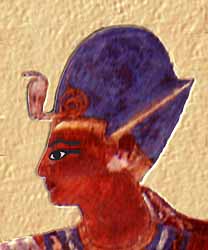
Madinat
Habre
The Temple of Ramesses III

Sea Peoples
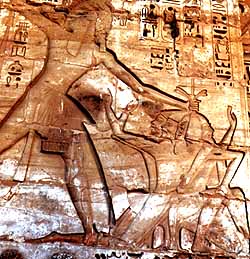
The giant figure of Ramesses II dominates the 19th Dynasty. He erected more buildings and statues than any other Egyptian king during his 66 year reign. Ramesses was very active militarily, especially against the Hittites in Syria with whom he eventually signed a peace treaty. His successors were faced with a series of invasions by Libyans and groups of foreigners called the Sea Peoples. They were finally defeated by Ramesses III (c.1198 - 1166 b.c.) of the 20th Dynasty. The prisoners of war settled in colonies and later became a powerful political force.
Carvings on wall of tomb

The Udjat eye
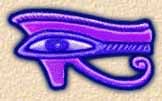
represents the eye of the god Horus which was torn from his head by the storm god, Seth. It is a composite of the human eye and the markings of a falcon's eye and was used as an amulet against injury.
The Pyramids of Giza
4th Dynasty (c.2613-22494 b.c.)
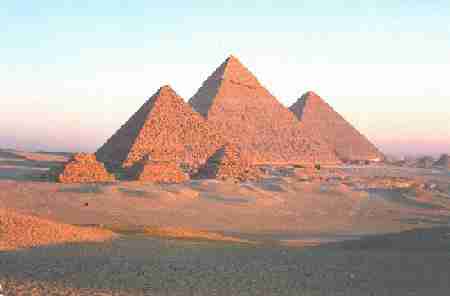
The age of the first ancient wonders of the world began with the pyramids of Sneferu who built three pyramids and who may have had a hand in others. His pyramid at Medum began
as a step pyramid
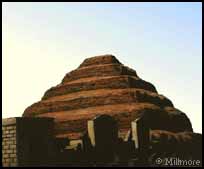 and was then modified to form the first true pyramid. He
built two pyramids at Dahshur. One was called
the Bent Pyramid because its upper part has a
shallower angle of inclination than the lower part. His pyramid at Medum
began as a step pyramid and was then modified to form the first
true pyramid.
and was then modified to form the first true pyramid. He
built two pyramids at Dahshur. One was called
the Bent Pyramid because its upper part has a
shallower angle of inclination than the lower part. His pyramid at Medum
began as a step pyramid and was then modified to form the first
true pyramid.
There are three pyramids of Giza, each of which once had an adjoining mortuary temple. Attached to this temple would have been a covered causeway descending down to a temple near the Nile. The great pyramid itself is truly an astonishing work of engineering skill. For over four thousand years, until the modern era, it was the tallest site in the world. The sides are oriented to the four cardinal points of the compass and the length of each side at the base is 755 feet. The sides rise at an angle of 51 52' to a height, originally of 481 to today's height of 451 feet. It was constructed using around 2,300,000 limestone blocks, weighing on average of 2.5 tons each although some weigh as much as 16 tons.
Some believe that his pyramid at Giza was built by slaves, but this is not true. One hundred thousand people worked on it for three months of each year. This was the time of the Nile's annual flood which made it impossible to farm the land and so, most of the population was unemployed. Khufu provided food and clothing for his workers and was remembered kindly in folk tales for many centuries. It is conceivable that by bringing so many people together and giving them a common goal, that of building a mountain, a national identity was forged in their hearts. From Upper and Lower Egypt, communities would have gotten to know each other and bonded in a joint endeavor to build this edifice. If this is true, how unique was it compared to other forms of nationalism that emerged from war.
King Tutankhamum
(1333 b.c. - 1323 b.c.)
Mask of Tutankhamun

The funeral mask of Tutankhamun was made in the traditional form of the god Osiris. It was believed that through a kind of imitative magic, his body would be reanimated as Osiris' had. The mask is made of gold with glass eyes and lapis lazuli eyebrows and eyelashes, the latter of which is identified with the sun god.
The tomb of Tutankhamun
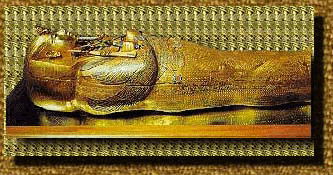
The discovery of the tomb of Tutankhamun led to an explosion of public interest in Egyptology. Tutankhamun was a young, minor king buried in a small, four room tomb. The treasure of King Tutankhamun's tomb was one of the greatest archeological discoveries in history. The largest section in the Virtual Museum is devoted to the treasures of this king, who ruled Egypt during the 18th Dynasty. His coffin was made of solid gold to represent Tutankhamun as the god Osiris. It is over six feet in length and about one eight of an inch thick. It turned the scale at 296 pounds troy. The tomb's uniqueness was that it was largely intact, except for some minor robbery in antiquity.
Tutankhamun's Bed
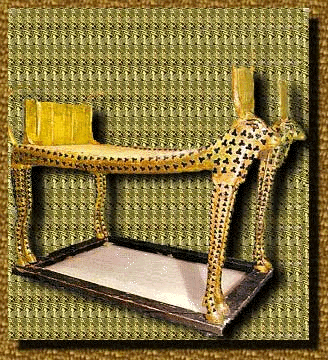
Tutankhamun's funeral bed is made in the bovine form of the goddess Hator with the solar disc between her horns. This is the bed on which Tutankhamun's coffin was layed.
The Shrine
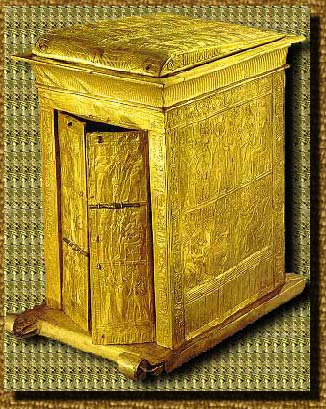
The shrine is made of wood and overlaid with a sheet of gold on a backing of plaster. It is mounted on a sledge overlaid with silver. It is an architectural model of the ancient shrine of the vulture goddess - Nekhbet of the North - known as the Great House.
The Tabernacle
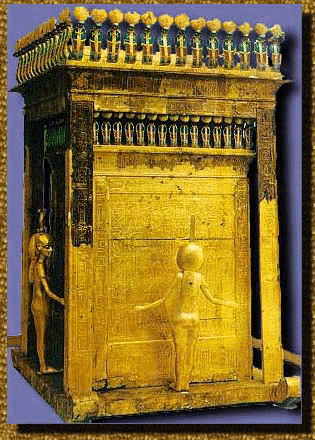
The tabernacle was found in the tomb of Tutankhamun. It contains the king's internal organs. It is made of gold plated wood and includes small coffins for each of the organs. It is flanked on all four of its sides by protective gods.
The Golden Throne
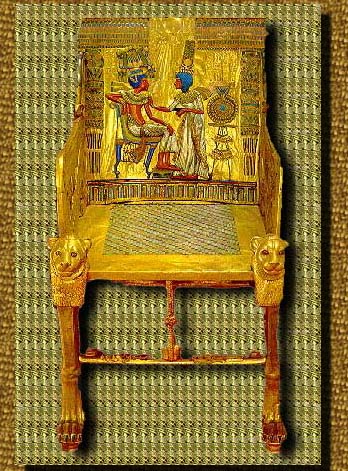
The Golden Throne was used for meetings of state. It is made of wood and overlaid with a sheet of gold. Its lion paw legs are mounted on beaded drums shod with either copper or bronze.
LIONS-HEAD
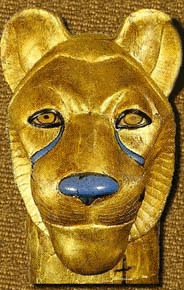
This carved lions-head is one of two which were placed on one of the beds found in the tomb of Tutankhamun. Although they are regarded as male, their features are the same as those of a commonly found lioness goddess, Sekhmet. Each opf the figures are carved wood, covered with a thin layer of plaster and gilded. The nose and eyes are made of colored glass.
TUTANKHAMUN EMERGING FROM THE LOTUS
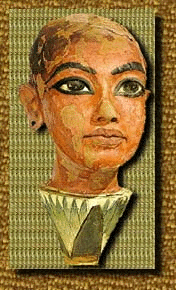
This object is a painted wooded lotus flower surmounted by a beautiful sculpture of Tutankhamun. He is emerging from the lotus just as the sun-god had done when he came into existence from a lotus flower on the surface of the ocean at the creation of the universe.
Netjer-ankh
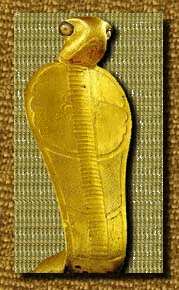
This cobra is identified as Netjer-ankh, or the "living god". It is made of gilded wood, and was found in one of the black shrines. Some of these shrines contained figures of underworld spirits. Illustrations on the walls of the New Kingdom show a serpent which shows the same name, and it is possible that this figure represents the serpent.
King Tutankhamun on a Panther
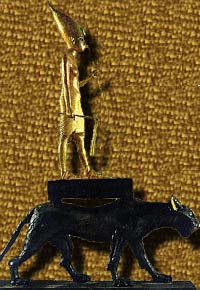
Statuette of gilded wood from the king's tomb, showing him as king of Upper Egypt, carrying a Flail in his hand and leaning upon a staff. A number of statuettes of this type, not more than two feet high, were found in the tomb.
Winged Scarab

A winged scarab in the image of the sun god at dawn, as it pushes the sun disk Re up into the sky.
Necklace
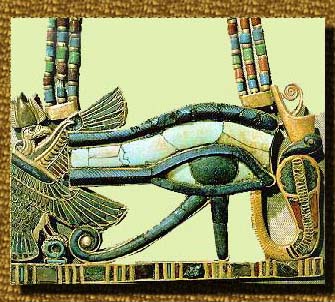
This necklace, which resides in the Cairo Museum, represents the right eye of Rê, the principle of light; the eye is framed by Uadjit the serpent, of the North, and Nekhebit, the vulture of the South. This piece of jewelry was found in the tomb of Tutankhamun, 18th Dynasty.
Crook and Flail

The Crook and Flail, the emblems of Osiris, were carried by kings on some ceremonial occasions. The Crook was found in a casket in the treasury. the Flail, at least, may have been used in Tutankhamun's coronation, due to the fact that it has the cartouche of both his childhood name, Tutankhaton, and the name he took as king, Nebkheperura. The Crook, however, bears only his throne name.
![]()
The beautiful and extraordinary objects that have survived from Egypt's ancient civilization have always triggered awe and wonderment. Although most have been found buried in tombs, many were originally intended for everyday use, and they give us an amazingly fresh and vivid picture of the living world of the ancient Egyptians.